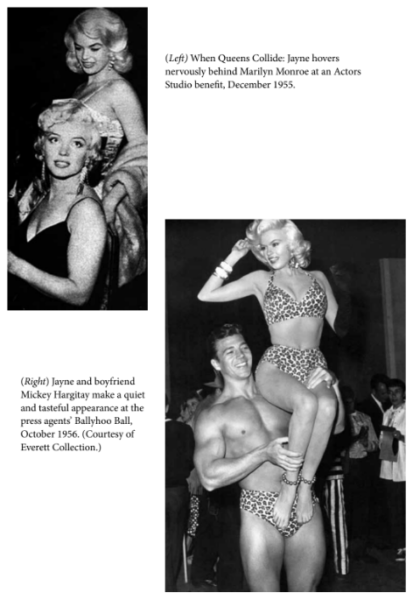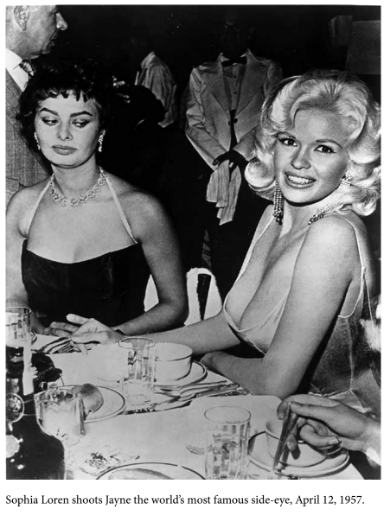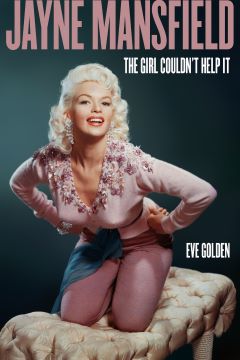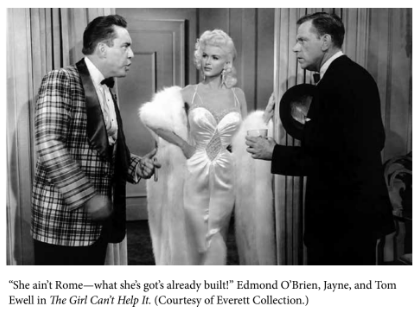A BUST OF PERSONALITY
“Ladies and Gentlemen, here they are, Jayne Mansfield.” Talk-show host Jack Paar allegedly paid his writer Dick Cavett $5,000 for that line and it pretty much says it all. He was of course referring to Ms. Mansfield’s celebrated twin assets, but as Eve Golden reveals in this ferociously readable biography, there were always two Jayne Mansfields: a dramatic actress who dressed like a stripper, an avowed Christian and serial adulteress, an animal-lover swathed in mink. Ms. Golden takes on the daunting task of reconciling these contradictions and succeeds admirably, giving us a vivid, well-rounded (no pun intended) account of a unique life.
Golden has many star biographies to her credit: her life of Kay Kendall, who also died tragically young, is definitive. She is particularly drawn to troubled lives and untimely deaths (Meryl Streep would probably have little appeal for her) and in this book subject and writer are well matched.
Mansfield lived in the great age of the gossip column, and few lives were more documented than hers. Golden takes full advantage of this wealth of material, quoting extensively from Mansfield’s stream-of-consciousness TV and print interviews, which include some highly questionable advice on nutrition, exercise and child-rearing. The book is also a goldmine of showbiz anecdotes and laugh-out-loud one-liners. Walter Matthau, starring with Jayne on Broadway in Will Success Spoil Rock Hunter? complained that she was up-staging him. On being told she did it only from inexperience, he replied, “Then how come she never down-stages me?”
Jayne Mansfield came, as they say, from nowhere. Born a brunette in Bryn Mawr, PA in 1933, she had a happy childhood with few of the trials and tribulations usually associated with celebrities’ early years. Almost as soon as she could talk, she had one goal in life, to be a star, and she pursued it single-mindedly until she achieved it. She hit Hollywood in 1953 at the age of nineteen, with a husband and daughter in tow, but Jayne never let obstacles like spouses or offspring get between her and the spotlight.
 In 1953, the biggest star in Hollywood (and the world) was Marilyn Monroe, reigning queen at 20th Century Fox. Every studio in town (including Fox) was on the lookout for the next Marilyn; someone as beautiful, desirable and talented as (but less trouble than) the original. Jayne took note of this, hit the peroxide bottle, and the rest is history.
In 1953, the biggest star in Hollywood (and the world) was Marilyn Monroe, reigning queen at 20th Century Fox. Every studio in town (including Fox) was on the lookout for the next Marilyn; someone as beautiful, desirable and talented as (but less trouble than) the original. Jayne took note of this, hit the peroxide bottle, and the rest is history.
She was signed to a seven-year contract at Fox, and in little more than a year had two major hits to her credit: The Girl Can’t Help It and Will Success Spoil Rock Hunter? In both films she pretty much plays herself, and it proved to be her most enduring role; to watch her sashay across the screen in a strapless red sequined dress is an education in itself. But then as now, things change fast in Hollywood, and as cultural phenomena go, the reign of the blonde bombshell was short. By the late fifties Hollywood had stopped making Jayne’s kind of movie, and a series of dramatic roles cruelly exposed her limits as an actress. Fox lost interest and started loaning her out to other studios. As the world entered the sixties, she started to look more and more like a relic of a bygone age. Even in mini-skirts and go-go boots her self-invented persona was inescapably trapped in the dumb blonde era.
Her career might have been on the skids, but Jayne’s personal (I almost wrote private) life still made news all over the world. Ms. Golden is particularly good in this area, taking us through three marriages, five kids, dozens of pets, and several love affairs without lapsing into sensationalism, and painting a vivid picture of life in the famous Pink Palace on Sunset. Mansfield’s second marriage, to bodybuilder Mickey Hargitay, appears to have been a genuine love match, though he finally tired of the role of child-minder and Chihuahua-walker and split after several years very hard labor. The loss of Mickey’s steadying influence was disastrous. The second half of the book charts an accelerating downward spiral, and frankly it becomes a bit of a slog; every supermarket opening, seedy nightclub date and wardrobe malfunction is recounted in exhaustive (not to say exhausting) detail. But there are still plenty of gossip-worthy moments; an encounter with the Beatles at the Whiskey a Go-Go is particularly gruesome.
With career moves and personal decisions becoming increasingly desperate, the denouement when it comes, has the inevitability of Greek tragedy. In the parlance of the time, something had to give, and it did. At 2:25 a.m. on June 29, 1967, a Buick Electra carrying Jayne, her current love Sam Brody, three of her children, the driver and four chihuahuas, rear-ended a tractor trailer en route to a club date in Biloxi, Mississippi. All three adults were killed instantly, the children and two dogs survived. How cruelly ironic that the woman who never made a really good movie had a death scene in the finest traditions of Hollywood, equaled only by that of James Dean, who at least had three classic films to his name.
 Which brings us to the one aspect (and it’s a crucial one) of Golden’s assessment with which I take issue. On sampling a dozen or so of Mansfield’s films, which for better or worse are accessible on YouTube, I reluctantly conclude that she was not a great, nor even a good, actress. Her dramatic performances are never more than competent, and her singing and dancing of the title song in Too Hot to Handle (clearly inspired, if that’s the right word, by Monroe’s “Diamonds Are a Girl’s Best Friend”) is embarrassingly amateurish. Golden is commendably generous on Jayne’s dramatic talents, describing barely adequate performances as “excellent” or “superb”, and expressing surprise that she was passed over for Anita Ekberg’s diva role in La Dolce Vita. She certainly had the build for the part, but maybe by 1959 she was too over-the-top even for Fellini. With respect to Ms. Golden’s point of view, Jayne Mansfield’s only truly memorable role was Jayne Mansfield.
Which brings us to the one aspect (and it’s a crucial one) of Golden’s assessment with which I take issue. On sampling a dozen or so of Mansfield’s films, which for better or worse are accessible on YouTube, I reluctantly conclude that she was not a great, nor even a good, actress. Her dramatic performances are never more than competent, and her singing and dancing of the title song in Too Hot to Handle (clearly inspired, if that’s the right word, by Monroe’s “Diamonds Are a Girl’s Best Friend”) is embarrassingly amateurish. Golden is commendably generous on Jayne’s dramatic talents, describing barely adequate performances as “excellent” or “superb”, and expressing surprise that she was passed over for Anita Ekberg’s diva role in La Dolce Vita. She certainly had the build for the part, but maybe by 1959 she was too over-the-top even for Fellini. With respect to Ms. Golden’s point of view, Jayne Mansfield’s only truly memorable role was Jayne Mansfield.
An artist’s legacy is more than a body of work on film or tape, it’s also the contribution he or she made to the era in which they lived. Jayne Mansfield’s unique legacy is more significant than her uneven performances in a succession of mediocre films. She challenged the sexual mores of her time, shook up the Fusty Fifties and helped pave the way for the Swinging Sixties. Not unlike Mae West before her, she took sex out of the closet and showed us it could be fun, not a cause for embarrassment or disapproval.
Famous for being famous, Jayne Mansfield achieved the notoriety she so fervently craved, if not the artistic recognition she supposedly aspired to. Today we’d call her a celebutante, if that word isn’t already out of date. She’d certainly have had a ball with social media, though as the interviews reveal, personal contact was always her strongest suit.
307 pages is a lot to devote to a career that was in decline almost from the get-go (Golden gives us all of Kay Kendall in 157 pages), but whether you’re a devoted Mansfield fan or you’ve never heard of her, Eve Golden makes abundantly clear what all the fuss was about.
photos courtesy and © University Press of Kentucky
Jayne Mansfield: The Girl Couldn’t Help It
University Press of Kentucky
452 pgs | 72 B&W photos
available June 29, 2021
pre-order at Amazon



{ 1 comment… read it below or add one }
Just wanted to tell you what a terrific review this is. I’m a bit biased about Ms. Golden, as she is one of my best friends, but she is, I believe, one of the best biographers working today.
By the way, did you read John Gilbert: The Last of the Silent Film Stars? It’s also excellent (and if you look inside, it’s dedicated to me and my husband, Ross).